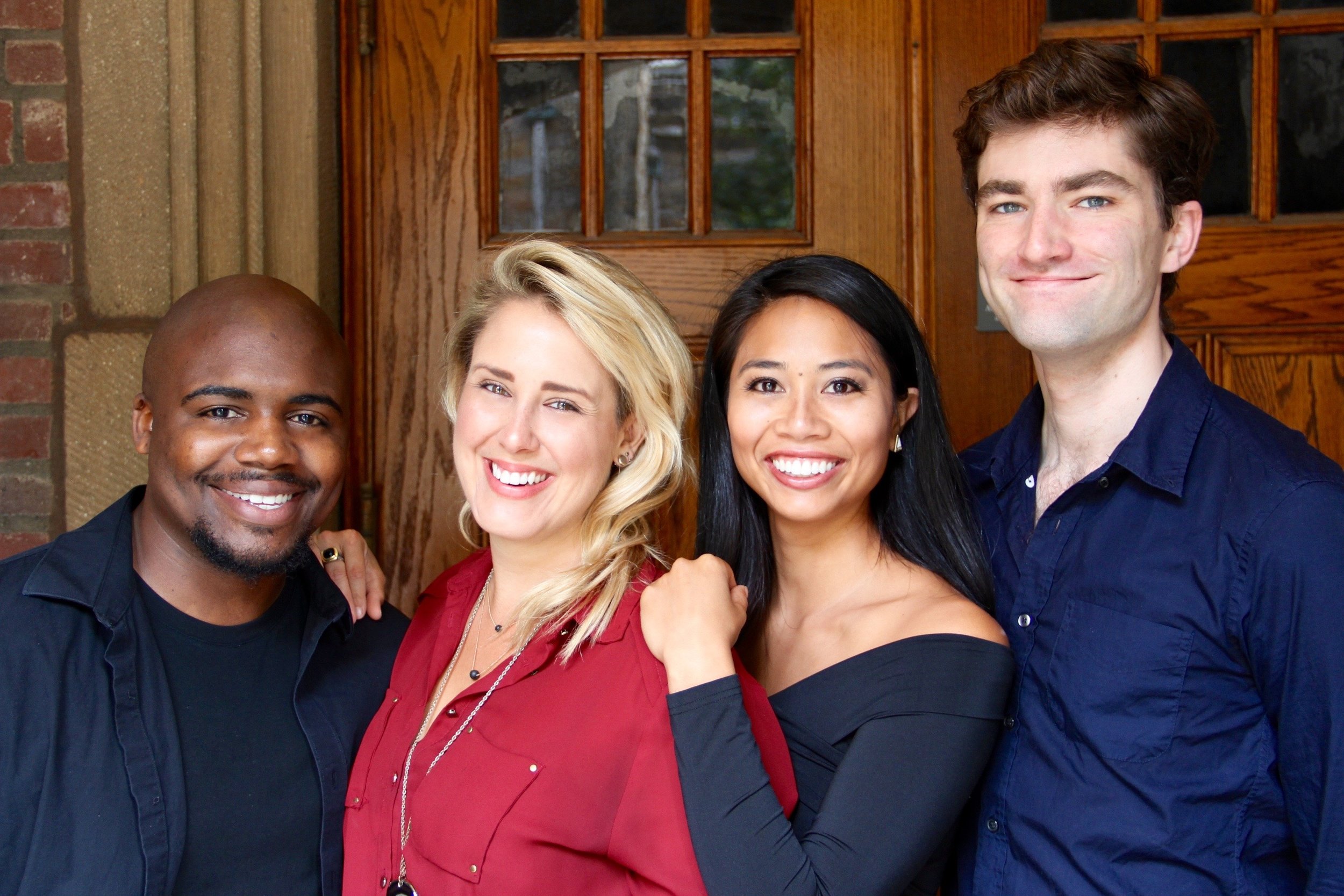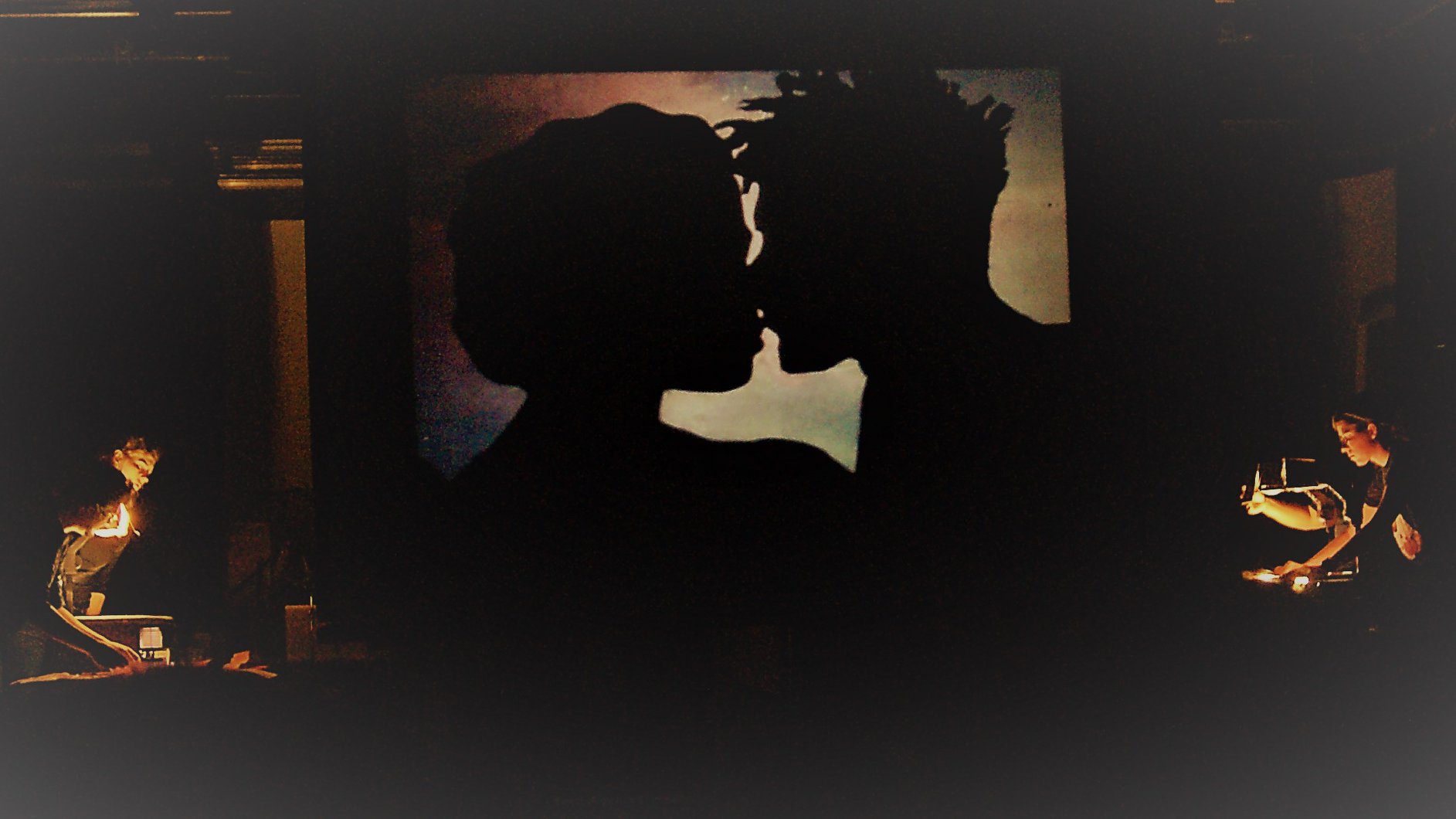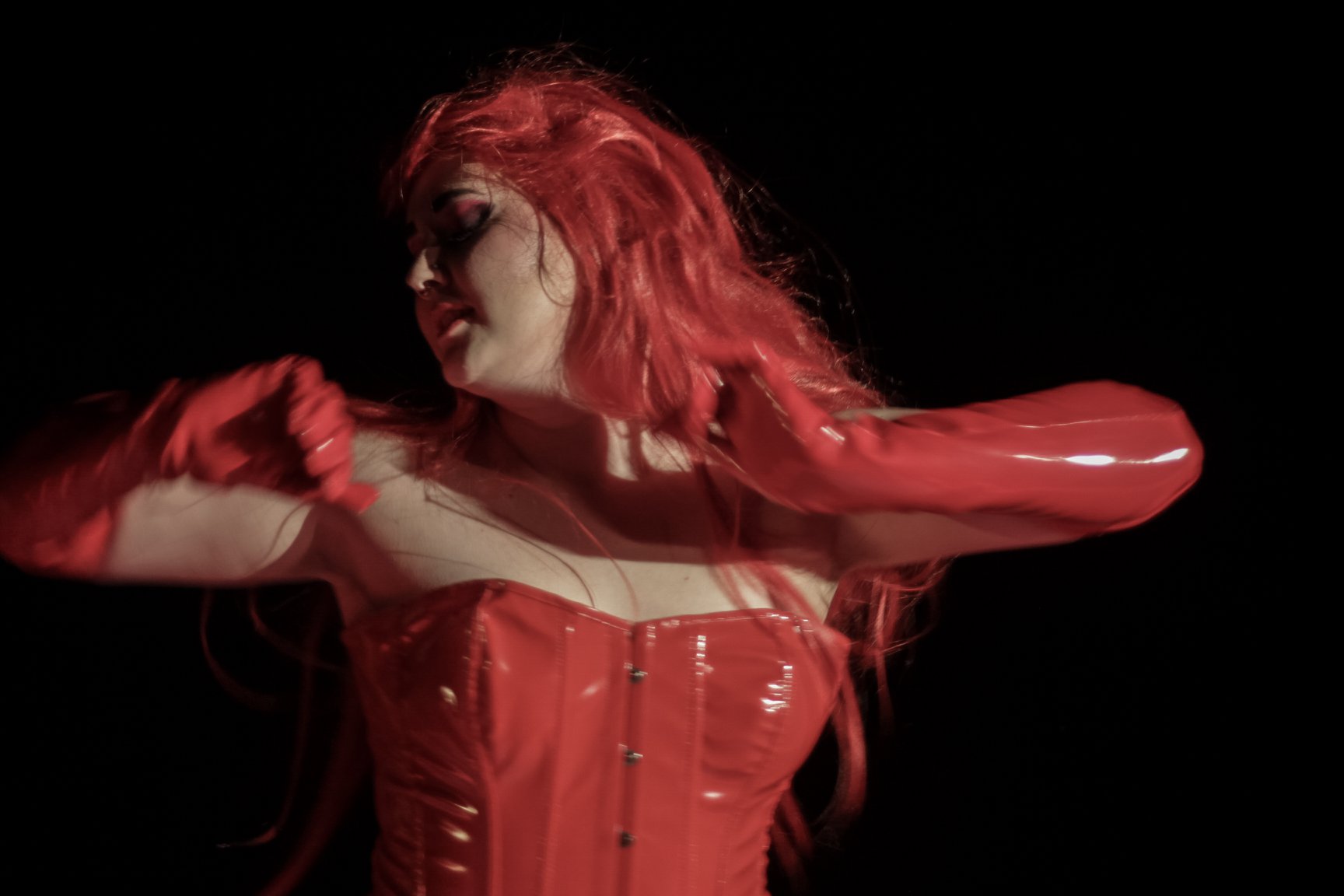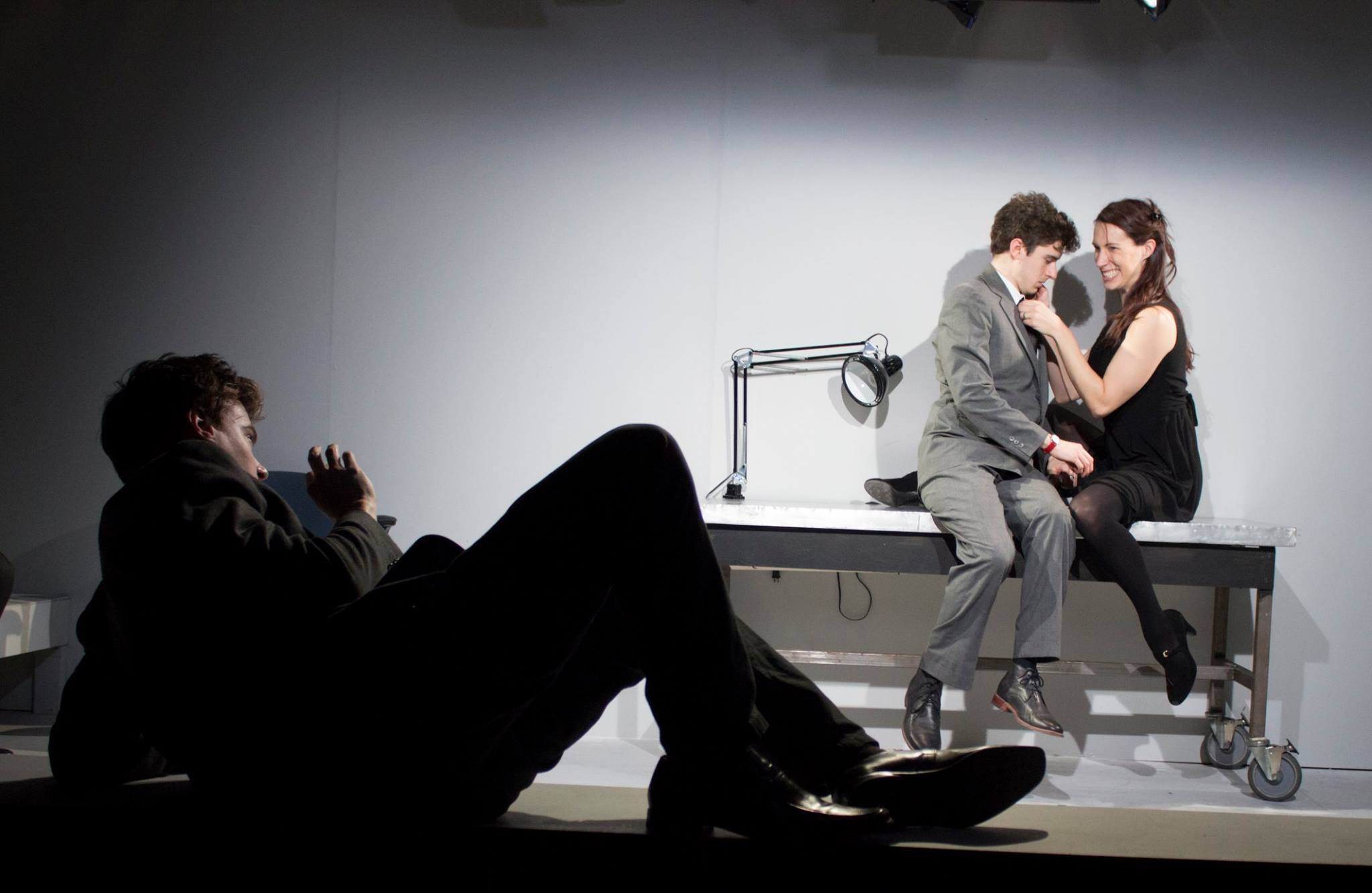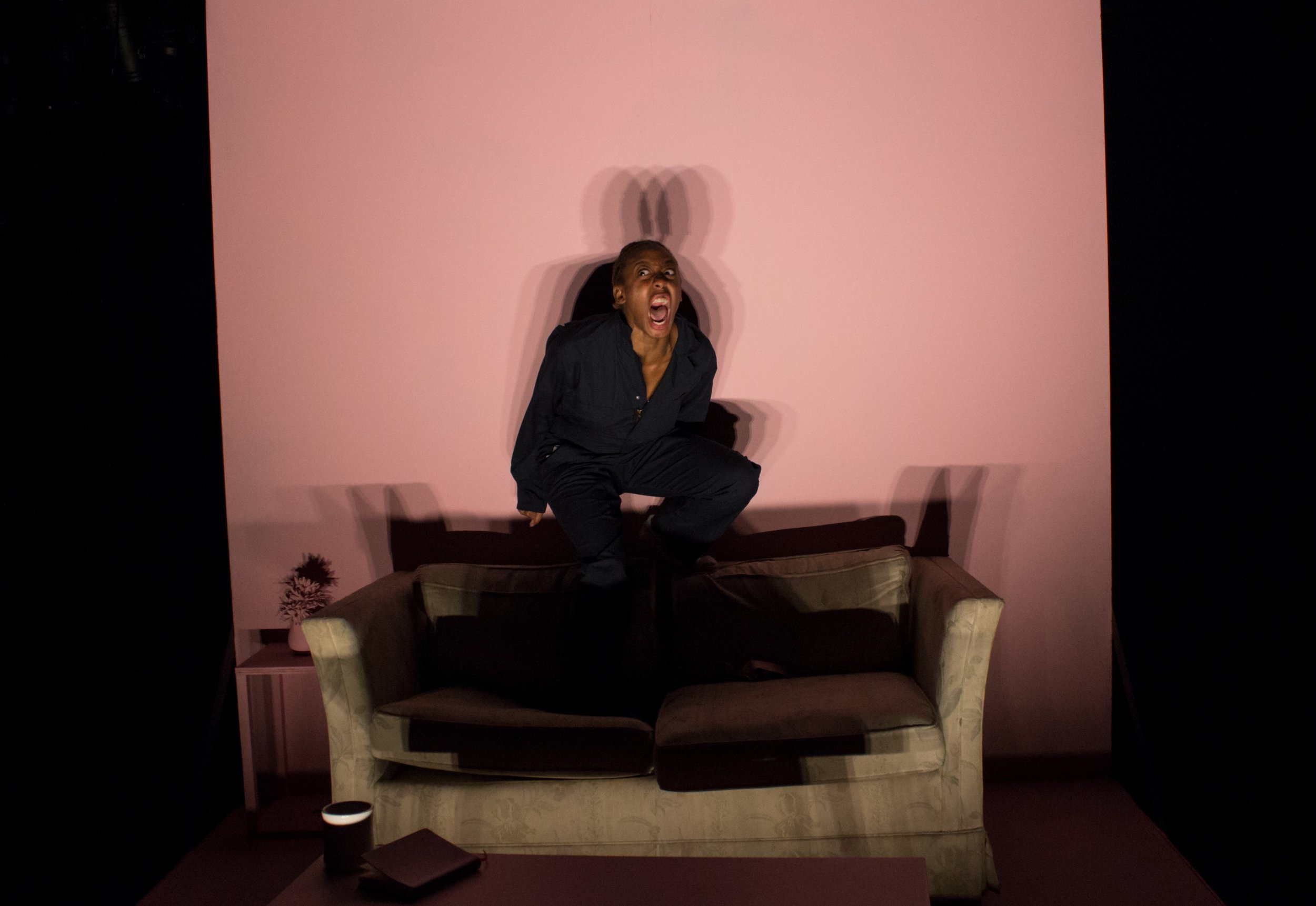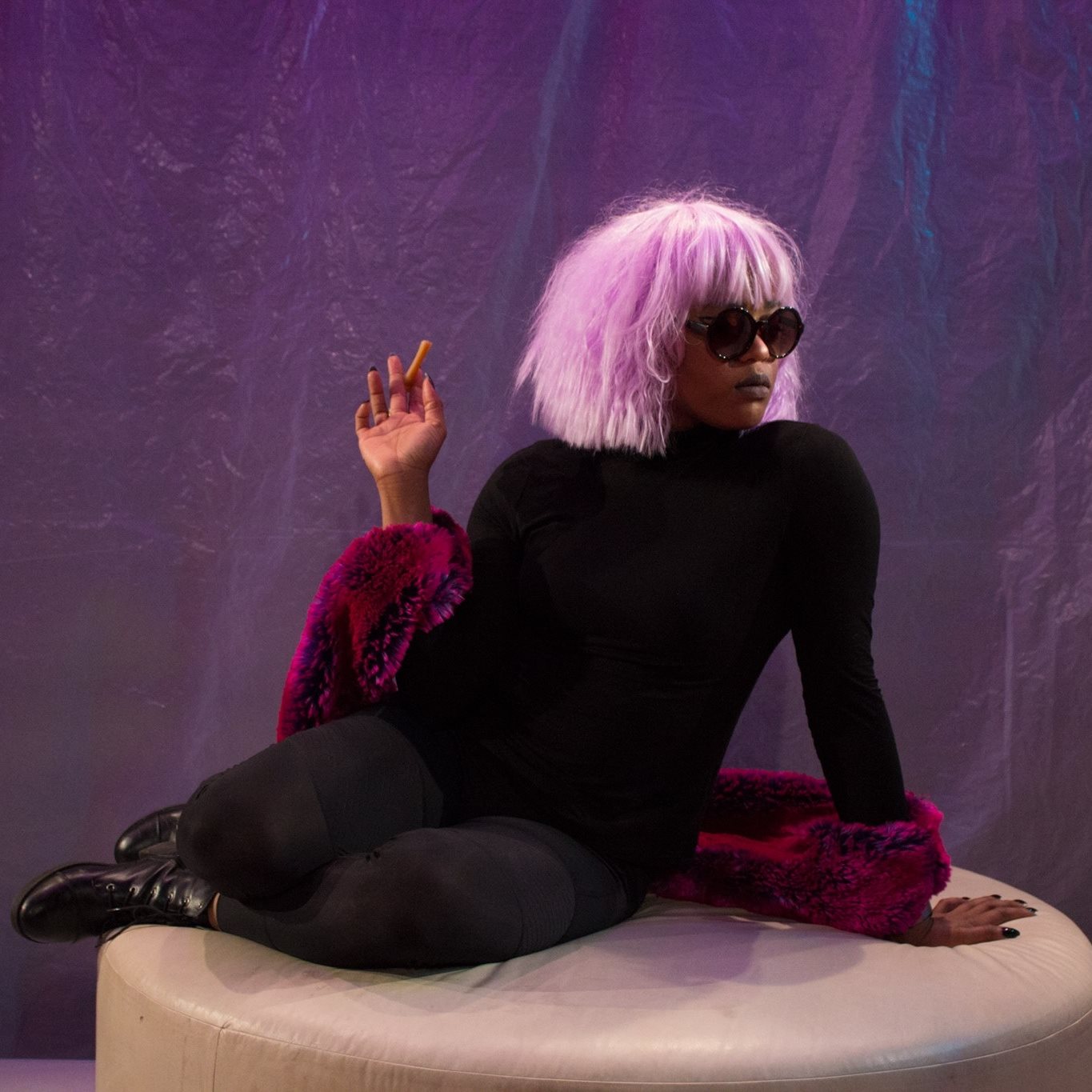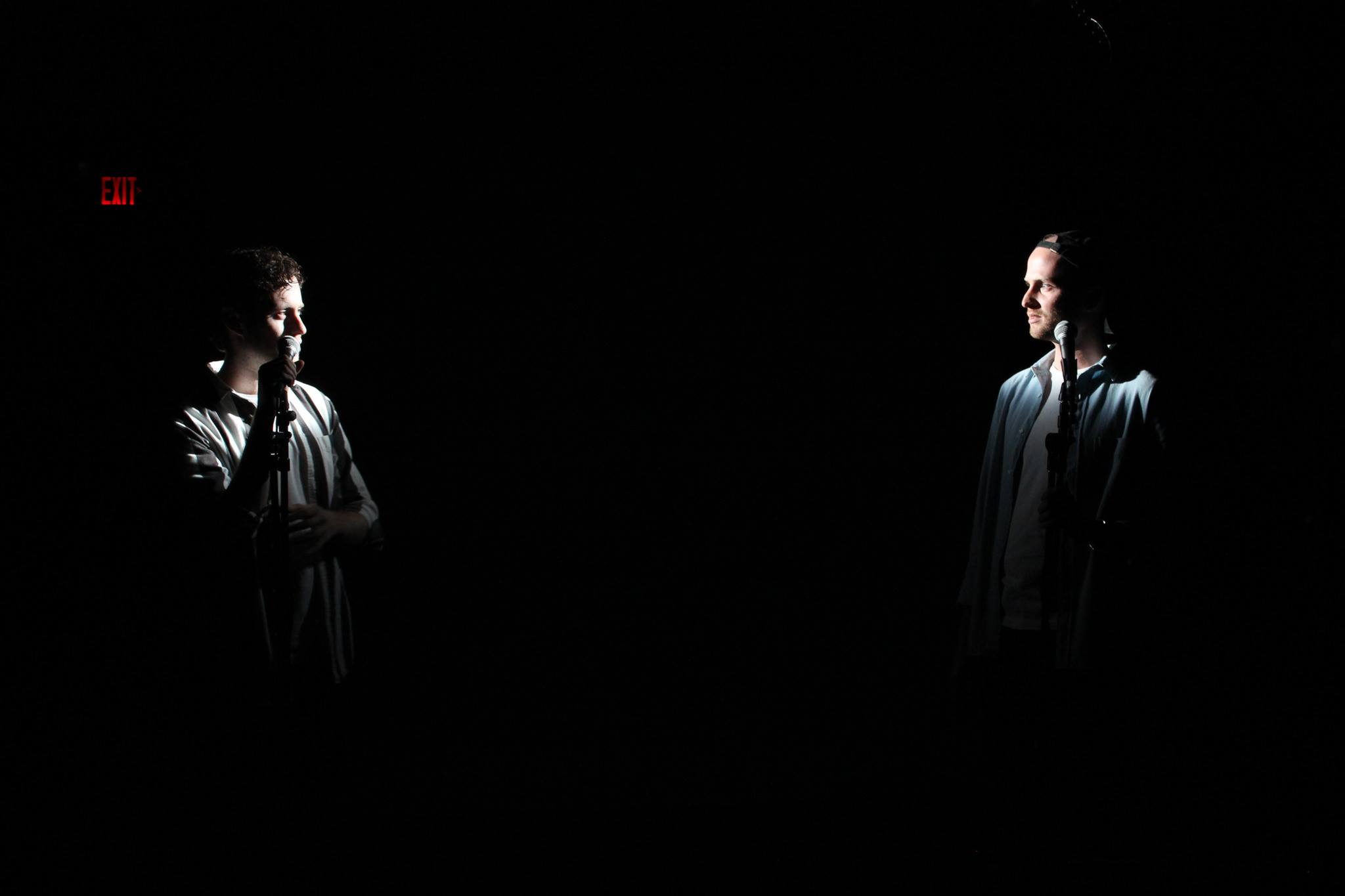Yale Cabaret’s 50th Season, Some Highlights
The 50th Anniversary season of the Yale Cabaret has been and gone. Much thanks to its artistic directors, Josh Wilder and Francesca Fernandez McKenzie, associate artistic director Rory Pelsue, and its managing director Rachel Shuey for a challenging season.
Josh Wilder, Rachel Shuey, Francesca Fernandez McKenzie, Rory Pelsue
Cabaret 50 offered plenty of off-beat fare, in the sense of plays in which the performers stood in a theatrical space between fiction and fact. We might think that Reality TV is having an impact, likewise we might think that the irreality of our current political climate makes fiction, no matter its intentions, seem a bit escapist. So, even the shows this season that were pre-existing plays seemed to take their tone from the tensions of our time, perhaps to an unusual degree.
Or maybe not. The way we—or each member of the audience—experiences what gets done before our eyes onstage takes its tone from our own conflicts, I expect. It seems to me that the Yale School of Drama students making theater in the basement at 217 Park Street in 2017-18 were particularly aware of the conflicts.
Here’s my own individually chosen favorite bits, in thirteen categories, with shows listed in chronological order but for my top choice, the choices in no way reflective of the views of any existing or imagined demographic.
Speaking of pre-existing plays, here are five I’m glad Cab 50 tackled:
Re:Union by Sean Devine (proposed by Wladimiro A. Woyno R.): Violent protest of the Vietnam War era and the sins of the fathers, including the bland bureaucrat Robert McNamara, is visited upon the next generation
This Sweet Affliction by Blake Hackler (proposed by Stephanie Machado): Treats comically the scary social effects of vying for attention and acting out
The Ugly One by Marius von Mayenburg (proposed by Lucie Dawkins): Plays fast and loose with our desire to be the most desired one in the room
Camille, A Tearjerker by Charles Ludlam (proposed by Michael Breslin and Molly FitzMaurice): Finesses a mix of melodrama and comedy in the name of Ridiculous Theater
and . . . Mud by María Irene Fornés (proposed by Danielle Chaves): A harrowing and uncomfortable allegory of how our bodies betray us
In the new play arena, some unusual offerings that lived up to the Cab’s brief of experiment and exploration:
Fuck Her by Genne Murphy: Call it science-fiction burlesque, a tale of a future where procreation by copulation is a status service
the feels… (kms) by Jeremy O. Harris: A script of inspired self-excoriation and abrasive ideas for ending it all
the light is… by Jake Ryan Lozano: A fascinating combination of poetic words and interpretive movements in atmospheric lighting
The Guadalupes by Noah Diaz: A funny, touching, and awkward remembrance play as real as anything onstage can be
and . . . This American Wife by Michael Breslin and Patrick Foley: The foley à deux of two gay guys who find the meaning of life in the bad behavior of televised housewives as a way of unmasking/masking themselves
Tech. Where would we be without it? These remarkably talented people do surprising work in a basement. Everyone who undertakes that task earns our gratitude. The samples here are simply those I can most readily call to mind.
Scenic Design:
Ao Li, The Apple Tree: Eden as a clean, white, well-lighted place . . . with a curtain
Sarah Nietfeld, This Sweet Affliction: Uniting the Cab space with several locales to up the intimacy
Gerardo Díaz Sánchez, Mud: Creating a simple but memorably derelict space
Emma Weinstein, Camille: Turning the entire Cab into a boudoir with a stage at the center
And . . . Stephanie Osin Cohen, Ni Mi Madre: A beach, a memory space, a museum, a shrine (and, oh, the colors)
Costumes:
Matthew Malone, The Apple Tree: From the white shorts & white first formal of innocence to the red everyday wardrobe of shame, plus one helluva snake suit
Stephanie Bahniuk, For Your Eyes Only: What the creative sex worker wears depends on the task at hand, with much showing and suggesting
April Hickman, Non-Character Player: Avatars dress for success (with props by Alexander McCargar) to add to the ambiance of the virtual world
Alicia Austin, Camille: Dress-up taken to the extremes of a fantasy-world of fashion, both comic and lovely
And … Beatrice Vena, Fuck Her: A future where clothes make the client and the client chooses the look
Lighting Design:
Krista Smith, with Emma Deane, The Apple Tree: A range of effects for this fanciful musical’s trajectory
Erin Earle Fleming, the feels… (kms): When the action is everywhere, even in the audience
Dakota Stipp, the light is… : The light, and the dark, as expressive elements with subtle cues
Emma Deane, Wolf/Alice: Gothic, moody, fascinating
And … Evan Anderson, One Big Breath: From shadow forms to indoors/outdoors spaces to in your face
Video/projections:
Wladimiro A. Woyno R., with Brittany Bland, Re:Union: Many events in the past exist for us as video; in this play, the action of the present took on the “pastness” of video
Erin Sullivan, The Guadalupes: Video here becomes a kind of self-surveillance, in an in-between theatrical space of public/private
Brittany Bland, Sea Witch: Opaque shadow-puppet foregrounds over colorful transparencies to create bewitching visuals
Christopher Evans, Jack Wesson, Non-Character Player: When theater becomes a virtual, digital space, and vice versa
And … Brittany Bland & Wladimiro A. Woyno R.; Michael Breslin; Amauto Marston-Firmino, This American Wife: The edited video from the television show provided context, the video within the performance, expressive device
Sound Design:
Megumi Katayama, One Big Breath: Total environmental theater with a varied soundstage
Frederick Kennedy, Re:Union: An interplay of video and live sound, including historical enactments and interpolations
Kathy Ruvuna, Sea Witch: Foley and musical effects, to create a textured aural backdrop in this wordless narrative
Roxy Jia, Megumi Katayama, Non-Character Player: What’s a digital video game without sound effects?
And … Liam-Bellman Sharpe, The Ugly One: Live Foley as a performance to the side of the main performance, which included onsite video
Music:
Frederick Kennedy, Liam Bellman-Sharpe, Mud: Moody background sounds that worked to focus us on the surprising events in Fornés’ world
Michael Costagliola, Hey Secret Service… A brave stand-up, proto-musical revue that considers the vexed relation between our twit(terer) of a president and the cultures of guns and of theater, and trumps its penciveness with wit and humor
Sylvia D’Eramo, Roxy Jia, Wolf/Alice: The singing by D’Eramo was stunning, the use of music atmospheric and eerie
Liam Bellman-Sharpe, Camille: Bellman-Sharpe is the great in-the-wings performer of Cab 50; here, at the piano, he added immeasurably to the play’s effectiveness
And … Jill Brunelle, music director, with Jenny Schmidt and Emily Sorenson; music by Jerry Bock, lyrics by Sheldon Harnick, sung by Erron Crawford, Danilo Gambini, Courtney Jamison, The Apple Tree: I often say I’m not the target audience for musicals, but when they’re directed by Rory Pelsue I change my tune, and Jill Brunelle is the maestro of musical adaptations for the Cab. Bravo!
Choreography:
Shadi Ghaheri, One Big Breath: The season opened with a memorable dance routine done by shadows with Jakeem Powell stealing the show
Ensemble, This Sweet Affliction: A topflight group of actresses as cheerleaders, strutting their stuff
Jake Ryan Lozano, the light is…: The range of emotions that movement and music inspires finds its focus in the many mute gestures of these mini-dramas of dance
Michael Breslin, Arturo Soria, Camille: An orchestration of movement—duels, dances, entrances/exits—very colorful and busy
And…Yasin (Ya-Ya) Fairley, Commissioned Choreographer, with Alex Vermilion and Chelsea Siren, For Your Eyes Only: Choreography, as dance, is only part of it; Vermilion’s show walked a fine line on the wild side, where every move is part of an elaborate fantasy trying to be reality, or vice versa
Acting takes many forms. One of its forms is a well-executed merging of a range of characters that feels as satisfying as a good band that’s got it together . . . Ensembles:
This Sweet Affliction, Stella Baker, Marié Botha, Patricia Fa’asua, Courtney Jamison, Rachel Kenney, Stephanie Machado (directed by Francesca Fernandez McKenzie): A group of girls, plus a few adults, coming apart, coping, not coping in a sharp social satire
the feels… (kms), Abubakr Ali, Michael Breslin, Patricia Fa’asua, Amandla Jahava, Jakeem Powell: A mercurial troupe acting out the different strands of a darkly comic use of theater as coping mechanism
The Ugly One, Danilo Gambini, Steven Johnson, Patrick Madden, Emily Reeder (directed by Lucie Dawkins): A frenetic collective caught up in the before-and-after benefits of radical surgery
Enter Your Sleep, JJ McGlone, Ciara McMillian (directed by Rachel Shuey): A two-hander that puts a pair of actors through their paces in a series of free-associated character turns
And . . . the light is…, Marié Botha, Shadi Ghaheri, Louisa Jacobson, James Udom, Seta Wainiqolo, Curtis Williams: I’m not sure what it was all about but I’d watch this group of actors read from the want-ads; here, they inspired a range of emotions in intricate choreography worked out by the cast and creator Jake Ryan Lozano, with a riveting Cab debut by Williams
Individual performances, because all roles aren’t created equal:
For playing his larger-than-life mother as himself or vice versa: Arturo Soria in Ni Mi Madre
For being both uncomfortably ugly and commandingly attractive, without benefit of make-up in either case: Patrick Madden in The Ugly One
For a scary yet pitiful version of toxic masculinity: Devin White in Mud
For a dream role as a dying diva in this period life: Michael Breslin in Camille
And … for letting us in and letting (some of) us have it, while working the slippery line between truth and appearance: Patrick Foley in This American Wife
For charming the first man, the serpent, and us (her children): Courtney Jamison in The Apple Tree
For hard truths and hard lessons handed down from the fathers: Louisa Jacobson in Re:Union
For a funny and chilling lesson in what happens when a theater person gets rejected (good thing she was an actress, not a dramaturg): Stephanie Machado in This Sweet Affliction
For a dream role as a mercurial and devious diva: Antoinette Crowe-Legacy in Fuck Her
And … for existential truth in its hunger, need, and abject beauty: Danielle Chaves in Mud
Directing, because someone has to be in charge:
Rory Pelsue, The Apple Tree: For a touching and amusing evocation of the pleasures of old-fashioned sexism set to music
Lucie Dawkins, The Ugly One: For finding the tone of absurdist satire for an image-conscious world
Emma Weinstein, The Guadalupes: For showing real life and real death in one life, almost as it happened
Molly FitzMaurice: Camille, A Tearjerker: For unleashing a cross-dressed extravaganza of wild indulgence
And … Patrick Madden, Mud: For rendering one of the most thoughtful and thought-provoking plays of the season
And, for overall production (or, simply, the shows I liked best overall):
The Apple Tree, producer Gwyneth Muller, dramaturg Molly FitzMaurice, Stage Manager Abby Gandy: A relentlessly entertaining and tuneful version of how we went from Eden to domesticity to death
This American Wife, producers Melissa Rose & Lucy Bacqué, dramaturgs Ariel Sibert & Catherine María Rodriguez, stage manager Olivia Plath: Ever-reflective reflection on how we like to imagine ourselves through others
This Sweet Affliction, producer Caitlin Volz, dramaturg Rory Pelsue, stage manager Sarah Thompson: Great fun at the expense of our obsession with belonging to the in-group and becoming more famous than our friends
Camille, A Tearjerker, producer Sophie Siegl-Warren, dramaturg Catherine María Rodriguez, stage manager Madeline Charne: A multivalent gender study and an entertaining exercise in flamboy/girlant acting
And … Mud, producer Leandro Zaneti, dramaturg Nahuel Telleria, stage manager Olivia Plath: A rich and mysterious play, Old School but undimmed
So, fifty years. Let’s see where they go from here…
The team for Cab 51 will be Artistic Directors Molly FitzMaurice and Latiana Gourzong and Managing Director Armando Huipe. There will be no Yale Summer Cabaret for 2018.
Much gratitude to all who took part in Cab 50 and in signature events like the 3rd Satellite Festival and the 5th “Dragaret.”
Yale Cabaret
2017-18
